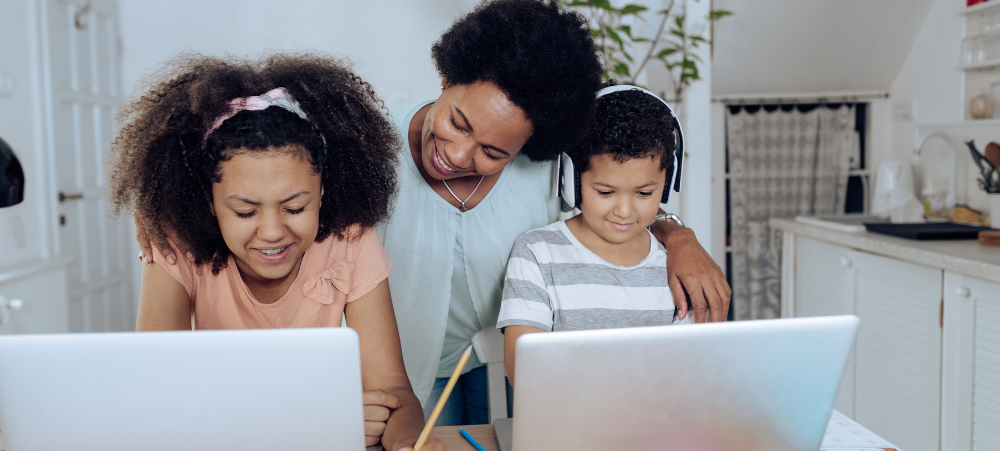Safety can take many forms – from physical and emotional to psychological. Your child’s perception of safety, or the lack thereof, can greatly affect how and what your child learns. Therefor it’s pivotal to create a safe and positive environment for learning at home, especially in a home-based learning setting.
According to a recent paper published by the American Institute for Research it starts by understanding what physical and emotional safety entails:
Physical safety—which includes preventing injury, protecting against violence from others or self-harm, and safeguarding against weapons and threats—is one of the most basic human needs. When someone does not feel safe, they will seek out ways to feel safe in their environment before they can attempt to meet any higher level of survival, like connecting with others or learning new skills.
Emotions trigger responses in our brain that affect how we feel and behave, and these emotions have a powerful effect on learning. For example, it is harder for us to learn when we are worried, angry, anxious, grieving, or humiliated because these emotions limit attention and concentration. When we feel emotionally safe—that is, when we feel calm, happy, and supported—our brains are better at taking in information, learning new things, and being productive.
It is also important to remember that children’s needs will be different based on their developmental age, gender, their strengths and needs, family expectations, and previous experiences with school. Your family’s culture and community norms will also influence your child’s needs. These differences will affect how children express themselves and how you respond to them. For example, younger children and children who have experienced trauma (for example abuse, divorce, or the loss of a loved one) may express anxiety by physically acting out or becoming more “clingy.” Adolescents, on the other hand, have great needs for respect, autonomy, and how they maintain their newly developing senses of their identity. As a result, they may react by working harder to protect their freedoms during this time of limitations, or by acting out with belligerence or withdrawal.
How do you proactively create the social and emotional conditions for learning?
- Make sure that YOU are ready to provide the physical and emotional safety your child needs.
- Seek help to prevent conflict or violence in your home.
- Make sure your child has their own physical space to learn where they are safe from fear, humiliation, or high levels of stress. Too many distractions can add to our stress, especially when we are trying to learn something new. Try to set aside a specific space—either a separate room or in a shared room—for your child’s learning time and work. If you have multiple children in the home, this may mean alternating space and resources like computers or other devices, so having a plan can help to minimize conflict.
- Accept your child for who they are and build on their strengths. Although all children will vary in their academic strengths and sense of who they are, it is essential that they develop a positive self-image. You play a critical role in helping them to develop that.
- Establish predictable routines at home. Doing so can prevent emotions like stress and can help your child’s brain to work better because they’ll know what to expect. Involving your child in creating the routine or schedule can not only teach them about time management, but also will help them to feel a sense of control. When responding to emotions, behaviours, or challenges:
- Make sure your child knows that they can express their feelings and share emotions with you.
- Let your child know that it is OK to make mistakes, especially when they are trying to learn new things in new ways. (This applies to you, too!) It’s important to remember that mistakes are how we learn. If your child makes a mistake, it can be helpful to talk through what might have gone wrong and what they could do differently next time. Encourage and reward persistence over perfection. Avoid punishing failure
- Listen, acknowledge, and affirm your child’s feelings. Help them identify what they or you can do to help them feel better.
- Discuss what is outside of your control and identify ways to deal with frustration. You can help your child to understand what they can and cannot control while acknowledging how they feel.
- Soothe children in ways that work for them. If you don’t know what works for them, have a conversation to learn more about what would work for both of you. Ask them about what helps them to calm down. If they don’t know, try different strategies together (like hugs, taking deep breaths, colouring a picture, or taking a walk) and talk about what was helpful.
- Monitor your child’s time online, in developmentally appropriate ways. Whereas younger children may need more support from an adult – thus making it easier to check on them – older youth and teenagers may want more privacy.
What to look out for
While children may tell you how they feel in words, they may also show signs in other ways. Please note that these signs won’t necessarily mean there is a problem. Knowing what to look for can help you to decide if you need to explore this more deeply or seek additional support. These signs will be different based on age, culture, and your individual experience.
Here are a few examples: Primary school children may show new or more irritability, aggressiveness, clinginess, nightmares, school avoidance, poor concentration, and withdrawal from activities and friends. Adolescents may reveal they are having problems by new or increased sleeping and eating disturbances, becoming more irritable and getting into more conflicts, physical complaints (for example, having a stomach-ache or headaches), delinquent behaviour, and poor concentration.
If you notice any of these signs or other new behaviours, it will be important to respond in a supportive way. Make sure your child knows that you are there to help them and that you will help them in a way that works for them.
“At Wingu Academy we take the wellbeing of our students very seriously. Our Wellness Hub has trained professionals that can assist parents and learners with guidance on both academic and emotional wellness. To us that is key, because our students learn from home. We always encourage our Wingu parents to put measures in place to ensure that students have a safe learning environment, and we assist wherever possible to ensure our Wingulians develop into thriving young individuals” says Ian Strydom, Managing Director of Wingu Academy.
Article content adapted from paper published by the American Institute for Research: https://www.air.org/sites/default/files/SAFETY_StratResrchFam-508_Rev06052020.pdf
- Wingu Academy’s Remote Learning Strategy: Delivering World-Class Education Across Continents - October 23, 2025
- Why Wingu Academy is a Premium Online School: Excellence in Every Learner’s Journey - October 16, 2025
- The Wingu Academy Online Teaching Approach: Personalised, Engaging, and Future-Ready - October 10, 2025





